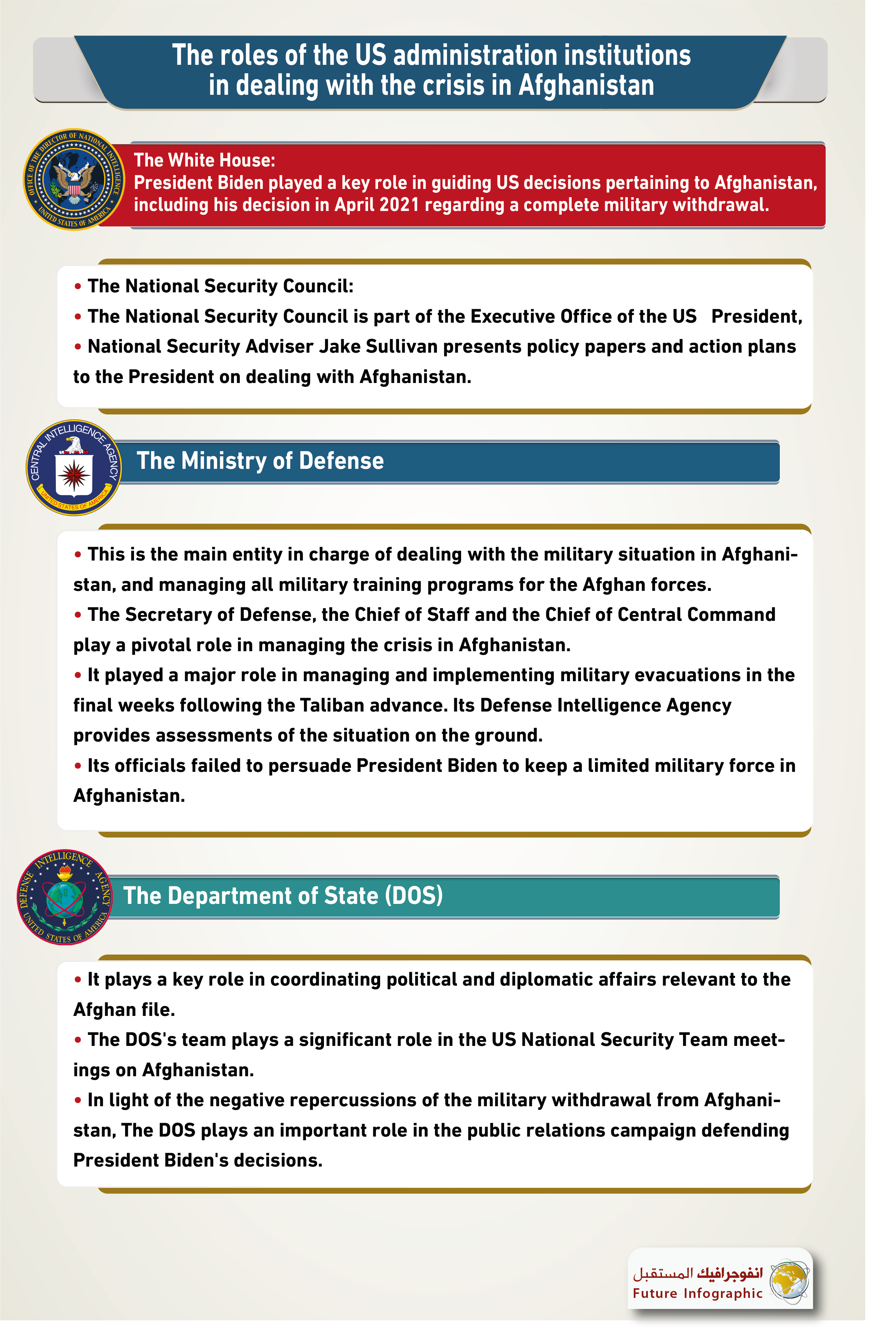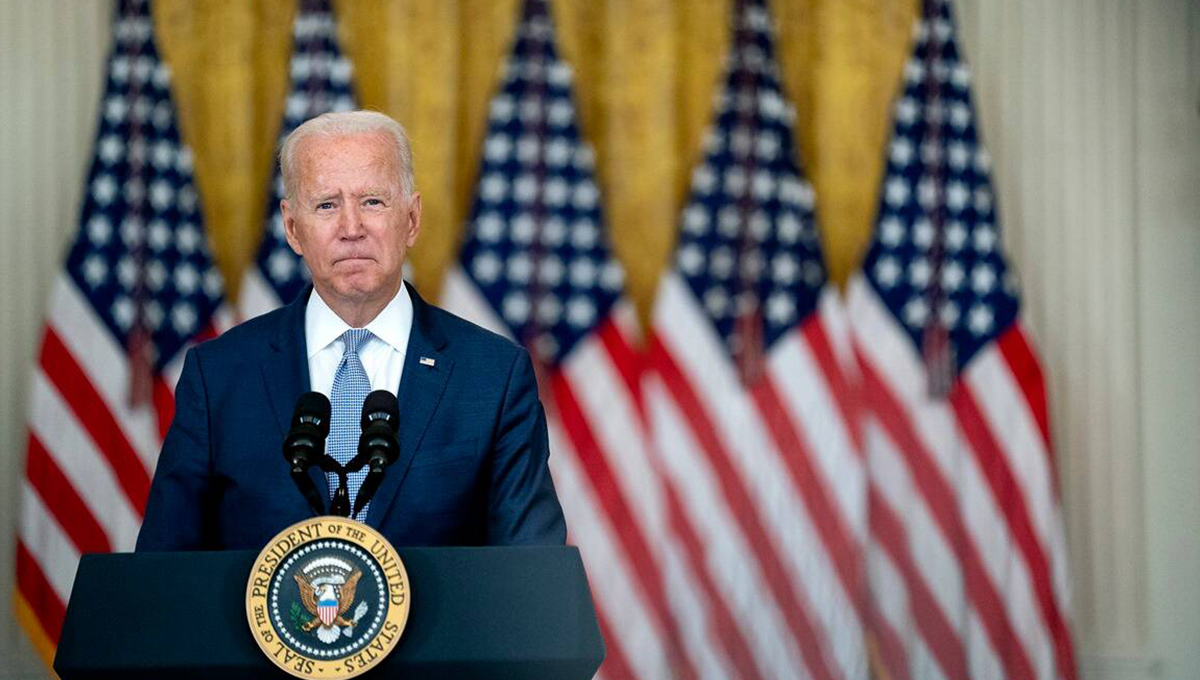Despite the decision of US President Biden, announced end of April 2021, to completely and permanently withdraw US forces from Afghanistan prior to next September 11, the recent developments of events in Afghanistan have forced the Biden administration, particularly the national security team, to deal with an emerging crisis, which is the fall of Kabul. This sudden crisis, which came partly as a result of Biden's decision and the divergent reactions of the US administration's institutions towards it, forced Washington to move at the military and political levels in an attempt to curb any expected short-term damage to US interests.
Strategic Goals
Afghanistan has been a constant nightmare for successive US administrations beginning with George Bush all the way to Joe Biden. However, the recent developments represented the most complex part of the Afghan crisis, given the need for the Biden administration to achieve several goals within tight constraints. These goals include:
1. The US military withdrawal:
The withdrawal from Afghanistan, which began at an accelerating pace in the last year of the Trump administration, continued under Biden administration, insisting on withdrawing all forces. This is unlike his predecessor, who decided, under pressures from the Pentagon, to maintain no more than 2,500 soldiers of the US forces on Afghan soil, to assist their Afghan counterparts in their missions, and to manage the possibility of the return of terrorist organizations in Afghanistan.
2. Securing US military forces and diplomats:
Although the US military withdrawal plan was proceeding normally, the developments within the last week, as the Taliban advanced on the ground and approached Kabul, forced the Biden administration and its institutions to work intensively to evacuate the military and US diplomats, securing the embassy facility in Kabul, and developing contingency plans to deal with any unforeseen developments. This explains dispatching new US force reaching 6000 soldiers to Afghanistan in order to carry out rapid evacuations, whether to US territory or to neighboring countries. US forces in neighboring countries were also put-on standby for further evacuations. Evacuation plans were quickly developed and implemented.
3. Managing the subsequent setbacks:
With the rapid developments of the Afghan crisis, particularly after the fall of Kabul, new factors emerged in the crisis management. They are linked to how the US administration dealt with the increasing criticism against Biden's decision to withdraw completely from Afghanistan, and holding him responsible for the fall of Kabul into the hands of the Taliban. The Republican criticism against this amounted to some comparing what happened in Afghanistan to the defeat of the US in Vietnam in 1975, and the concerns regarding the impact of this criticism on the mid-term congressional elections in November 2022.
Additionally, the credibility gap has begun to widen with Washington’s foreign allies. Regional and international allies are starting to believe that the US is no longer the power to be relied on, particularly since decisions in handling the Afghan file is forcing other countries to follow its lead, which has made the Taliban the force most capable of steering events on the ground.
Internal Differences
The differences in positions within the institutions of the US administration, particularly prior to the period 12 to 16 August, contributed massively to the worsening situation within Afghanistan. Although there is a unified position between the National Security Council, the State Department, and the Ministry of Defense regarding the decision of military withdrawal from Afghanistan, there was no consensus over the issue of maintaining limited US forces to assist their Afghan counterparts and to manage the possibility of the return of terrorist organizations. This is in addition to the inaccurate assessments of the US intelligence services about the situation on the ground, which led to a shift from managing the military withdrawal process to managing the crisis of Kabul's fall into the hands of the Taliban.
The following points are worth mentioning in this respect:
1- The Voice of the President:
Biden has always called for a complete military withdrawal, and is supported by the National Security Council and the State Department teams in this direction. Although the military team was opposed to the decision of a complete withdrawal and was pressing towards keeping a limited number of US forces, Biden was never convinced of this direction. Although the US military was supposed to be the influential voice in decisions relevant to Afghanistan, given their professional military expertise, their influence was limited on the internal consultations, due to the absence of support by the National Security Council and the State Department.
2- The role of the intelligence community:
The development of intelligence assessments on the situation in Afghanistan rests mainly with 3 US intelligence institutions: the Defense Intelligence Agency of the Pentagon, which mainly works on assessing the military situation on the ground. Then comes the CIA, which focuses on the activity of terrorist organizations. Finally, the Office of the Director of National Intelligence coordinates between them and the White House as well as other intelligence entities.
Statements by Pentagon officials reflect a clear failure in the assessments of Defense Intelligence Agency of the Taliban's ability to advance militarily on the ground. Although these assessments were partially correct about the prediction of the fall of Kabul to the movement, they were largely inaccurate about the timing of the fall. In April 2021, the intelligence services of the US Department of Defense expected the fall of Kabul within a year to 18 months. Then, later in July, they expected its fall within 6 months. With the recent developments, they came back to expect the fall of the Afghan capital within 3 months to several weeks. And yet, the world was surprised by the fall of Kabul to the Taliban in less than 3 days.

Crisis Management
The Biden administration and the US national security team dealt with the Afghanistan crisis in two phases; the first phase started with Biden's decision on a complete withdrawal from Afghanistan prior to the anniversary of September 11. During this period, the US was managing the Afghan file normally, focusing on the withdrawal arrangements and plans to deal with the Afghans, who cooperated with the US forces, and working with the Congress to expedite the procedures for bringing them in.
The second stage started August 12 until now, where the Biden administration is considering the developments in Afghanistan as an emergency crisis associated with US interests. The crisis has been dealt with within this framework through several levels, including:
1- Militarily:
At this level, Washington focused on managing and implementing rapid military evacuations, including completing and expediting the withdrawal of US forces, and securing the evacuation of US diplomats and US citizens from Afghanistan, and the Afghans who collaborated with US forces. This level was managed by the Pentagon and USCENTCOM. Coordination has been made with some military units in the US armed forces, to send forces to implement evacuation plans, while the USCENTCOM manages coordination operations relevant to evacuations.
2- Politically:
The US administration politically managed the crisis of the fall of Kabul, according to three levels:
a. Level 1: the administration in charge of communication with the Taliban liaison office in the Doha ensured sending specific messages to the movement’s leaders not to carry out any operations against the US embassy or against US soldiers and civilians, and not to carry out any military operations at the Kabul airport.
b. Level 2: This was represented in a public relations campaign to address the US public, led by President Biden, Secretary of State, Anthony Blinken, and National Security Advisor, Jake Sullivan. In this context, President Biden addressed the US public, initially through a press release issued by the White House on behalf of the President on August 14, followed by a general speech by Biden to the American people on August 16. In the statement and speech, President Biden focused on specific messages, particularly defending his decision to withdraw from Afghanistan, explaining and providing justifications for this decision.
Meanwhile, both the Secretary of State and the National Security Advisor were responsible for appearing on news networks to explain and defend the position of the US administration, specifically with regard to asserting that the moment of the fall of Kabul and the US exit from Afghanistan are not at all similar to what happened in Vietnam. While the Biden administration focused mainly on the domestic public opinion, it did not exert evident efforts at the diplomatic level in coordinating and communicating with allied countries during the management of the crisis of the fall of Kabul. This may be due to the pressures of events and time, or due to the allies also treating the situation as an emergency.
c. Level 3: this level is also relevant to a domestic front, mainly the Congress. The development of events in Afghanistan, which descended upon the Biden administration, put it in a difficult position with the Republicans in Congress, and even with the Democrats themselves who found themselves in a critical position regarding how to defend the current policies in light of the disintegrating situation and the tragic scenes from the capital, Kabul.
Accordingly, the Democrats, particularly the progressive wing that was in favor of maintaining a limited number of US forces in Afghanistan, found themselves compelled to defend the Biden administration, especially in light of the sharp attack from the Republicans who want to capitalize on any mistakes by the current administration to impact the midterm congressional elections battle. The White House has assigned a number of US administration officials to provide a briefing to key members of Congress while they are outside Washington, DC. Intensive meetings with members at the Capitol building are scheduled after their return from vacation.

In conclusion, President Biden's decision regarding the full withdrawal of US forces from Afghanistan, and not keeping a limited number to support the Afghan army, together with other factors, contributed to hastening the victories of the Taliban movement and the fall of Kabul. The US administration suddenly found itself in the midst of an emergency crisis relevant to the need to protect US interests in Afghanistan, and to protect the US embassy there from being exposed to a Taliban intrusion, similar to the US hostage crisis in Iran in 1979. This led Washington to implement emergency evacuation plans, as well as launching an internal public relations campaign to defend Biden's decision and its rationale. Nevertheless, the success of Biden and his team in managing this crisis does not mean that its negative repercussions and the shameful image of the hasty US withdrawal from Afghanistan will ever be erased from history.


